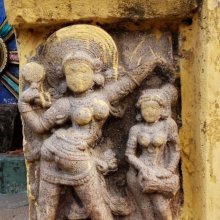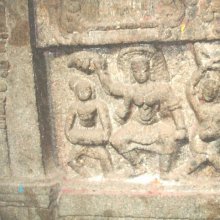Headgear, Head-gear: 2 definitions
Introduction:
Headgear means something in Hinduism, Sanskrit. If you want to know the exact meaning, history, etymology or English translation of this term then check out the descriptions on this page. Add your comment or reference to a book if you want to contribute to this summary article.
Images (photo gallery)
In Hinduism
Purana and Itihasa (epic history)
Source: Shodhganga: Elements of Art and Architecture in the Trtiyakhanda of the VisnudharmottarapuranaHeadgear was traditionally used for decorating the head, as part of the “sixty four kinds of Art”, according to the Kamasutra of Vatsyayana.—Cf. the Sanskrit Śekharakāpīḍayojana.—Indian tradition, basically includes sixty four Art forms are acknowledged. The history of Indian Art covers approximately five thousand years which presents a rich and almost continuous record. The references of sixty four kinds of Kala (कला, kalā) are found in the Bhagavatapurana, Shaiva-Tantras, Kamasutra of Vatsyayana etc.

The Purana (पुराण, purāṇas) refers to Sanskrit literature preserving ancient India’s vast cultural history, including historical legends, religious ceremonies, various arts and sciences. The eighteen mahapuranas total over 400,000 shlokas (metrical couplets) and date to at least several centuries BCE.
Natyashastra (theatrics and dramaturgy)
Source: Shodhganga: Elements of Art and Architecture in the Trtiyakhanda of the Visnudharmottarapurana (natya)Head-gears were commonly used as Ornaments (in Indian Dramas) as conveyed through the Alaṃkāra division of Āhāryābhinaya: one of the four divisions of Abhinaya or “ways to convey or represent one’s emotion to others”, according to the Viṣṇudharmottarapurāṇa, an ancient Sanskrit text which (being encyclopedic in nature) deals with a variety of cultural topics such as arts, architecture, music, grammar and astronomy.—Alaṃkāra deals with the decoration of garlands and ornaments. In the Nāṭyaśāstra four kinds of ornaments and five kinds of garlands are accepted. In the Sanskrit dramas ornaments like ear-rings, bracelets, head-gears etc. are seen to be collected from nature. This is informed in many of the Sanskrit dramas.

Natyashastra (नाट्यशास्त्र, nāṭyaśāstra) refers to both the ancient Indian tradition (shastra) of performing arts, (natya—theatrics, drama, dance, music), as well as the name of a Sanskrit work dealing with these subjects. It also teaches the rules for composing Dramatic plays (nataka), construction and performance of Theater, and Poetic works (kavya).
See also (Relevant definitions)
Partial matches: Head.
Full-text (+42): Citapagu, Viracimmuri, Ushnishapatta, Jallupagu, Ucciyani, Konkatai, Mauli, Korepeta, Lappatte, Gaddemadirumalu, Gubukattu, Battatale, Matthavattige, Kavika, Gabbige, Kiripamce, Apida, Yuvarajapatta, Ushnisha, Shirastrana.
Relevant text
Search found 30 books and stories containing Headgear, Head-gear; (plurals include: Headgears, gears). You can also click to the full overview containing English textual excerpts. Below are direct links for the most relevant articles:
Puppetry in Assam (by Gitali Saikia)
Folk Theatre (e): Bharigan < [Chapter 6]
Folk Theatre (b): Ojapali < [Chapter 6]
Costume of puppets of Assam < [Chapter 4]
The Jataka tales [English], Volume 1-6 (by Robert Chalmers)
Jataka 82: Mittavinda-jātaka < [Book I - Ekanipāta]
Jataka 536: Kuṇāla-jātaka < [Volume 5]
Mahabharata (English) (by Kisari Mohan Ganguli)
Temples of Munnur (Historical Study) (by R. Muthuraman)
Images of Chakrathalvar < [Chapter 5]
Other Images < [Chapter 5]
Images of Jeshta (Jyestha) < [Chapter 5]
Pallava period (Social and Cultural History) (by S. Krishnamurthy)
Head-dress during warfare < [Chapter 4 - Material Culture of the People]
Composition of army and system of warfare < [Chapter 4 - Material Culture of the People]
Crowns for Men (a): Kirita-makuta < [Chapter 4 - Material Culture of the People]


